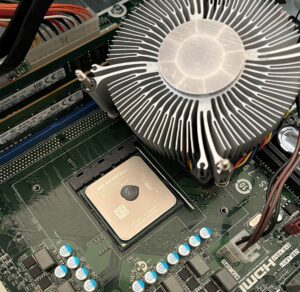Thermal paste, also known as thermal compound or thermal grease, is a substance applied between a CPU (Central Processing Unit) and a heat sink to improve the thermal conductivity between them. Its primary purpose is to fill in microscopic imperfections on the surfaces of the CPU and heat sink, ensuring better heat transfer.
When a CPU operates, it generates heat, and efficient heat dissipation is crucial to prevent the CPU from overheating. The thermal paste helps in enhancing the thermal conductivity between the CPU and the heat sink, allowing heat to transfer more effectively from the CPU to the heat sink. This, in turn, helps to keep the CPU temperature within safe operating limits.
Our Recommendation
If you’ve recently acquired an older refurbished computer, we highly recommend monitoring current cpu temps to see if they are optimal and if not, we suggest applying fresh thermal paste. We typically just do this by default in most cases with refurbs and based off the age of the computer.
But how often do I really need to re-apply fresh thermal paste?
The frequency of reapplying thermal paste depends on various factors, including the type of thermal paste used, the quality of the initial application, and the operating conditions of the computer. In general, it’s not necessary to reapply thermal paste very often. Here are some guidelines:
- Factory Applied Paste: If your computer is brand new or has factory-applied thermal paste, there’s usually no need to reapply it for several years.
- High-Quality Paste: If you used a high-quality thermal paste during the initial application, it can remain effective for a longer time. Some premium thermal pastes can last for several years without significant degradation.
- Normal Usage: For most users with standard computer usage patterns (e.g., browsing, office work, occasional gaming), it’s typically recommended to check the thermal paste every 3-5 years.
- Intensive Usage: If your computer undergoes heavy usage, such as gaming, video editing, or other resource-intensive tasks, you might consider checking and potentially reapplying thermal paste every 2-3 years.
- Temperature Monitoring: Regularly monitoring your CPU temperatures can provide insights. If you notice a significant increase in temperatures over time, it might be an indicator that the thermal paste needs replacement.
10 year old CPU still using the same original thermal paste from the factory, got a fresh coat today, yay! We used Corsair’s TM30 Performance Thermal Paste in the below example ->


